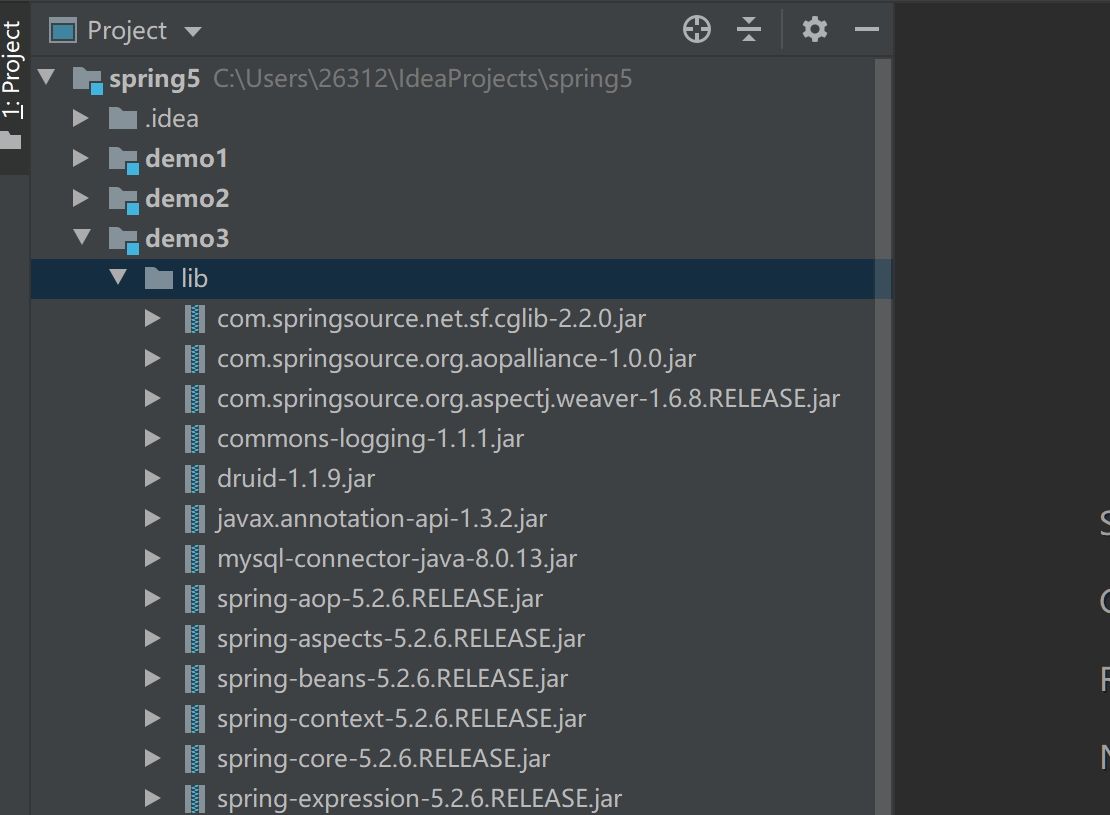【第五章 AOP概述,底层原理,AOP术语,切入点表达式,AOP操作(基于注解方式,基于xml配置文件)】

第五章 AOP概述,底层原理,AOP术语,切入点表达式,AOP操作(基于注解方式,基于xml配置文件)
1.AOP概述:
(1)什么是AOP:
①面向切面编程(方面),利用AOP可以对业务逻辑的各个部分进行隔离,从而使得业务逻辑各部分间的耦合度降低,提高程序的可重用性,同时提高开发的效率。
②通俗描述:不通过修改源代码方式,在主干功能里面添加新功能。
(2)底层原理:
①AOP底层使用动态代理:有两种情况动态代理。
第一种,有接口情况:使用jdk动态代理;
创建接口实现类代理对象,增强类的方法。
第二种,没有接口情况,使用CGLIB动态代理。
创建子类的代理对象,增强类的方法。
②AOP(jdk动态代理):
a.使用jdk动态代理,使用Proxy类里面的方法创建代理对象。
调用newProxyInstance方法
方法有三个参数:
第一个参数:类加载器。
第二个参数:增强方法所在类,这个类实现的接口,支持多个接口。
第三个参数:实现这个接口InvocationHandler,创建代理对象,写增强的方法。
b.编写jdk动态代理代码。
第一步:创建接口,定义方法;
public interface UserDao {public int add(int a,int b);public String update(String id);
}
第二步:创建接口实现类,实现方法;
public class UserDaoImpl implements UserDao {@Overridepublic int add(int a, int b) {System.out.println("add方法执行了");return a+b;}@Overridepublic String update(String id) {System.out.println("update方法执行了");return id;}
}
第三步:使用Proxy类创建接口代理对象;
public class JDKProxy {public static void main(String[] args) {//创建接口实现类代理对象Class[] interfaces={UserDao.class};UserDaoImpl userDao=new UserDaoImpl();UserDao dao = (UserDao) Proxy.newProxyInstance(JDKProxy.class.getClassLoader(), interfaces, new UserDaoProxy(userDao));int result = dao.add(1, 2);System.out.println("result"+result);}
}
//创建代理对象代码
class UserDaoProxy implements InvocationHandler{//把创建的是谁的代理对象,把谁传递过来//有参数的构造进行传递private Object obj;public UserDaoProxy( Object obj){this.obj=obj;}//增强的逻辑@Overridepublic Object invoke(Object proxy, Method method, Object[] args) throws Throwable {//方法之前System.out.println("方法之前执行"+method.getName()+":传递参数--->"+ Arrays.toString(args));//被增强的方法执行Object res = method.invoke(obj, args);//方法之后System.out.println("在方法之后执行"+obj);return res;}
}
(3)AOP术语:
①连接点:类里面哪些方法可以被增强,这些方法称为连接点。
②切入点:实际被真正增强的方法,称为切入点。
③通知(增强):实际增强的逻辑部分称为通知(增强)
通知有多种类型:前置通知、后置通知、环绕通知、异常通知、最终通知(类似于try-catch中的finally)
④切面:把通知应用到切入点的过程。
2.AOP操作(准备工作):
(1)在spring框架中一般基于AspectJ实现AOP操作。
AspectJ:不是spring组成部分,独立AOP框架,一般把AspectJ和spring框架一起使用,进行AOP操作。
(2)基于AspectJ实现AOP操作。
①基于xml配置文件实现;
②基于注解方式实现。
(3)在项目中引入AOP依赖:
 (4)切入点表达式:
(4)切入点表达式:
①切入点表达式作用:知道要对哪个类里面的哪个方法进行增强。
②语法结构:
execution([权限修饰符] [返回类型] [类全路径名] [方法名称] [参数列表])
举例1:对demo1.dao.BookDao类里面的add进行增强
execution(* demo1.dao.BookDao.add(..))
举例2:对demo1.dao.BookDao类里面的所有方法进行增强
execution(* demo1.dao.BookDao.*(..))
举例3:对demo1.dao.包里面的所有类,类里面的所有方法进行增强
execution(* demo1.dao.*.*(..))
3.AOP操作(AspectJ 基于注解方式)
(1)创建类,在类里面定义方法;
//被增强类
public class User {public void add(){System.out.println("add......");}
}
(2)创建增强类,编写增强逻辑
①在增强类里面,创建方法,让不同的方法代表不同通知类型。
//增强类
public class UserProxy {//前置通知public void before(){System.out.println("before....");}
}
(3)进行通知的配置
①在spring配置文件中,开启注解的扫描
<?xml version="1.0" encoding="UTF-8"?>
<beans xmlns="http://www.springframework.org/schema/beans"xmlns:xsi="http://www.w3.org/2001/XMLSchema-instance"xmlns:context="http://www.springframework.org/schema/context"xmlns:aop="http://www.springframework.org/schema/aop"xsi:schemaLocation="http://www.springframework.org/schema/beans http://www.springframework.org/schema/beans/spring-beans.xsdhttp://www.springframework.org/schema/context http://www.springframework.org/schema/context/spring-context.xsdhttp://www.springframework.org/schema/aop http://www.springframework.org/schema/aop/spring-aop.xsd"><!--开启注解扫描--><context:component-scan base-package="aopano"></context:component-scan>
②使用注解创建User和UserProxy对象
@Component
public class User {}
@Component
public class UserProxy {}
③在增强类上面添加注解@Aspect
@Component
@Aspect
public class UserProxy {}
④在spring配置文件中开启生成代理对象
<!--开启Aspect生成代理对象--><aop:aspectj-autoproxy></aop:aspectj-autoproxy>
(4)配置不同类型的通知
①在增强类里面,在作为通知方法上面添加通知类型注解,使用切入点表达式配置
//增强类
@Component
@Aspect
public class UserProxy {//前置通知@Before(value = "execution(* aopano.User.add(..))")public void before(){System.out.println("before....");}
}
测试的时候执行的是被增强的方法@Testpublic void testAopno(){ApplicationContext applicationContext=new ClassPathXmlApplicationContext("bean2.xml");User user = applicationContext.getBean("user", User.class);user.add();}

//前置通知@Before(value = "execution(* aopano.User.add(..))")public void before(){System.out.println("before....");}//最终通知@After(value = "execution(* aopano.User.add(..))")public void after(){System.out.println("after....");}//后置通知@AfterReturning(value = "execution(* aopano.User.add(..))")public void afterReturning(){System.out.println("afterReturning....");}//异常通知@AfterThrowing(value = "execution(* aopano.User.add(..))")public void afterThrowing(){System.out.println("afterThrowing....");}//环绕通知@Around(value = "execution(* aopano.User.add(..))")public void around(ProceedingJoinPoint proceedingJoinPoint) throws Throwable {System.out.println("环绕之前");//被增强的方法执行proceedingJoinPoint.proceed();System.out.println("环绕之后");}
 (5)公共切入点进行抽取:
(5)公共切入点进行抽取:
//相同切入点进行抽取@Pointcut(value = "execution(* aopano.User.add(..))")public void pointdemo(){}//前置通知@Before(value = "pointdemo()")public void before(){System.out.println("before....");}
(6)有多个增强类对同一个方法进行增强,设置增强类优先级。
在增强类的上面添加注解@Order(数字类型值),数字类型值越小,优先级越高。
@Component
@Aspect
@Order(1)
public class personProxy {@Before(value = "execution(* aopano.User.add(..))")public void afterReturning(){System.out.println("person before ....");}
}
4.AOP操作(AspectJ 基于xml配置文件方式)(了解)
(1)创建两个类,增强类和被增强类,创建方法;
public class Book {public void buy(){System.out.println("buy.....");}
}
public class BookProxy {public void before(){System.out.println("before....");}
}
(2)在spring配置文件中创建两个类对象;
<!--创建两个类的对象--><bean id="book" class="aopxml.Book"></bean><bean id="bookProxy" class="aopxml.BookProxy"></bean>
(3)在spring配置文件中配置切入点。
<!--aop的增强--><aop:config ><!--切入点--><aop:pointcut id="p" expression="execution(* aopxml.Book.buy(..))"/><!--配置切面--><aop:aspect ref="bookProxy"><!--增强作用在具体的方法上--><aop:before method="before" pointcut-ref="p"></aop:before></aop:aspect></aop:config>


